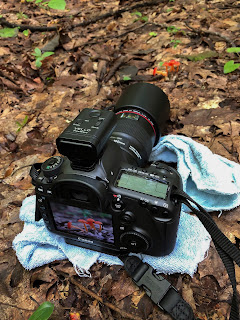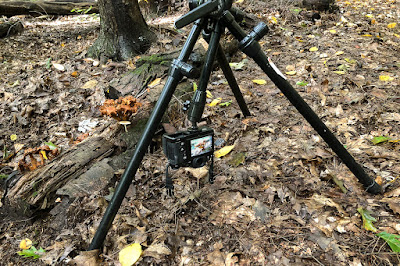The colorful fungi quickly attract my attention as I roam the woodlands. These are barely more than one inch high. To show them, the camera must be low. It is just like photographing small children. The camera needs to be at their level to avoid images of the tops of the mushroom caps.
And, since there was not much light deep in the forest, the exposure was slow, requiring the camera to be motionless. In this case, the shutter was at 1/15 second.
 These 'shrooms were too low to even use a tripod, so I improvised. The camera is supported by some pieces of old towel carried to dry gear when it rains. Once the camera is in position, and the rear screen shows a good focus, I am ready to use a little trick. I use the shutter delay normally used so the photographer has time to quickly join the group of people in the photo. This avoids shaking the camera when pressing the shutter. It works perfectly.
These 'shrooms were too low to even use a tripod, so I improvised. The camera is supported by some pieces of old towel carried to dry gear when it rains. Once the camera is in position, and the rear screen shows a good focus, I am ready to use a little trick. I use the shutter delay normally used so the photographer has time to quickly join the group of people in the photo. This avoids shaking the camera when pressing the shutter. It works perfectly.You can do this. Fill a small bag with something like dried beans and cradle your camera in it. Be sure the camera is not too close to focus. Set the timer like I did, and you have it.
On this day, I continued my exploration and soon spotted a violet color on the forest floor. It is a coral mushroom. Beautiful. I was lucky with this fungi, and could support the camera on a tripod for another slow shutter in the dark woods.
While I am roaming the woods, I sometimes come upon a cluster of shelf mushrooms on a fallen tree. In this case, I simply pulled out my smartphone and quickly captured the rich patterns and colors. These are commonly called turkey tail mushrooms. Unlike the ephemeral forms, the shelf mushrooms do not quickly disappear, but they do look their best when they are wet.
The variety of fungi forms is part of what excites me during my quests. This one was a big surprise to me. Beyond the colors, the form seemed to match the famous line of "E.T. phone home."
I will admit to having dug out part of the leaf litter to get my camera in position for the above image. I simply would not be satisfied with a poor composition for this fungi.
Most of my photos use natural lighting, but sometimes the underneath of the cap mushrooms is just too dark. I came upon a cluster of finely textured mushrooms on a fallen poplar tree. In the next case, I popped a little bit of flash from beneath to bring out what I was seeing.
 Getting low is a constant aspect of this pursuit. There is another annoying way to get low. It calls for turning the center column of a tripod upside down and hanging the camera on it. The annoyance comes from working with the camera upside down as seen below.
Getting low is a constant aspect of this pursuit. There is another annoying way to get low. It calls for turning the center column of a tripod upside down and hanging the camera on it. The annoyance comes from working with the camera upside down as seen below.With a little practice, the benefits are worth the effort, and really, it soon becomes very manageable. Here is the result of the setup shown above.
The exposure was 1/4 second, so even if I laid flat on the ground and hand held the camera, the photo would have been blurry.
On a recent morning at the Ringwood Preserve near Freeville, I put the upside down approach to the test. This pair of large mushrooms were on a steep hillside. The upside down approach allowed me to work without sliding down the bank.
This time, I used another trick to balance the light on the underside of the caps. I put my cell phone on the flashlight mode, and lightly painted the caps with soft warm light. I like it better than using a flash because I can see the best position before triggering the shutter.
As I gathered my gear to leave Ringwood preserve, I should have known something would capture my attention. This may be the same mushroom I previously found on the poplar log.
Here, I also used my cell phone flashlight to paint the underneath of the cap. It was a good find.
For the photographers, I hope a few of these techniques are of value. Photographer or not, I also hope these images inspire you to take a closer look at the fall mushrooms that are present present. I even find them in my garden and lawn right now.
Paul Schmitt

















































